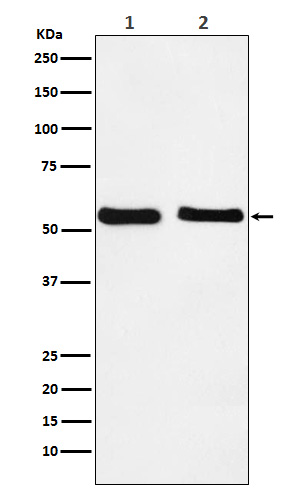KLF10 Antibody
Rabbit mAb
- SPECIFICATION
- CITATIONS
- PROTOCOLS
- BACKGROUND

Application
| WB |
|---|---|
| Primary Accession | Q13118 |
| Reactivity | Rat |
| Clonality | Monoclonal |
| Other Names | EGR alpha; EGRA; Egral; EGRalpha; Gdnfif; KLF10; mGIF; TIEG; TIEG1; |
| Isotype | Rabbit IgG |
| Host | Rabbit |
| Calculated MW | 52555 Da |
| Dilution | WB 1:500~1:2000 |
|---|---|
| Purification | Affinity-chromatography |
| Immunogen | A synthesized peptide derived from human KLF10 |
| Description | Transcriptional repressor which binds to the consensus sequence 5'-GGTGTG-3'. Plays a role in the regulation of the circadian clock; binds to the GC box sequence in the promoter of the core clock component ARTNL/BMAL1 and represses its transcriptional activity. |
| Storage Condition and Buffer | Rabbit IgG in phosphate buffered saline , pH 7.4, 150mM NaCl, 0.02% sodium azide and 50% glycerol. Store at +4°C short term. Store at -20°C long term. Avoid freeze / thaw cycle. |
| Name | KLF10 |
|---|---|
| Synonyms | TIEG, TIEG1 |
| Function | Transcriptional repressor which binds to the consensus sequence 5'-GGTGTG-3'. Plays a role in the regulation of the circadian clock; binds to the GC box sequence in the promoter of the core clock component ARTNL/BMAL1 and represses its transcriptional activity. Regulates the circadian expression of genes involved in lipogenesis, gluconeogenesis, and glycolysis in the liver. Represses the expression of PCK2, a rate-limiting step enzyme of gluconeogenesis (By similarity). May play a role in the cell cycle regulation. |
| Cellular Location | Nucleus {ECO:0000250|UniProtKB:O89091}. |

Thousands of laboratories across the world have published research that depended on the performance of antibodies from Abcepta to advance their research. Check out links to articles that cite our products in major peer-reviewed journals, organized by research category.
info@abcepta.com, and receive a free "I Love Antibodies" mug.
Provided below are standard protocols that you may find useful for product applications.
If you have used an Abcepta product and would like to share how it has performed, please click on the "Submit Review" button and provide the requested information. Our staff will examine and post your review and contact you if needed.
If you have any additional inquiries please email technical services at tech@abcepta.com.













 Foundational characteristics of cancer include proliferation, angiogenesis, migration, evasion of apoptosis, and cellular immortality. Find key markers for these cellular processes and antibodies to detect them.
Foundational characteristics of cancer include proliferation, angiogenesis, migration, evasion of apoptosis, and cellular immortality. Find key markers for these cellular processes and antibodies to detect them. The SUMOplot™ Analysis Program predicts and scores sumoylation sites in your protein. SUMOylation is a post-translational modification involved in various cellular processes, such as nuclear-cytosolic transport, transcriptional regulation, apoptosis, protein stability, response to stress, and progression through the cell cycle.
The SUMOplot™ Analysis Program predicts and scores sumoylation sites in your protein. SUMOylation is a post-translational modification involved in various cellular processes, such as nuclear-cytosolic transport, transcriptional regulation, apoptosis, protein stability, response to stress, and progression through the cell cycle. The Autophagy Receptor Motif Plotter predicts and scores autophagy receptor binding sites in your protein. Identifying proteins connected to this pathway is critical to understanding the role of autophagy in physiological as well as pathological processes such as development, differentiation, neurodegenerative diseases, stress, infection, and cancer.
The Autophagy Receptor Motif Plotter predicts and scores autophagy receptor binding sites in your protein. Identifying proteins connected to this pathway is critical to understanding the role of autophagy in physiological as well as pathological processes such as development, differentiation, neurodegenerative diseases, stress, infection, and cancer.


